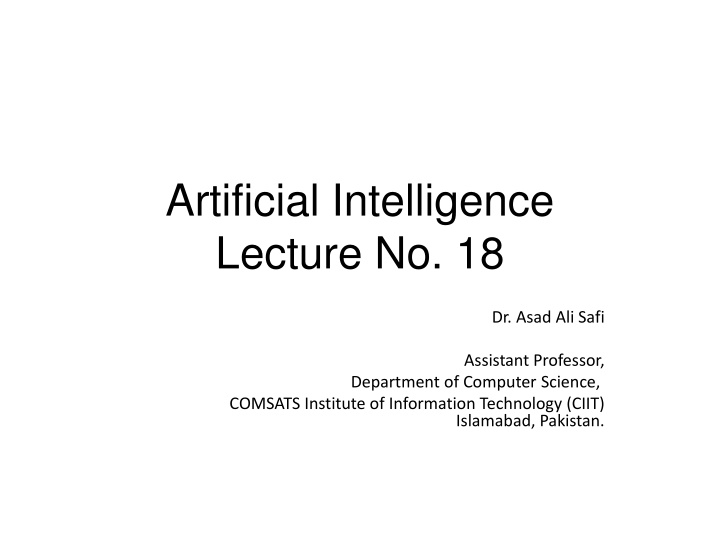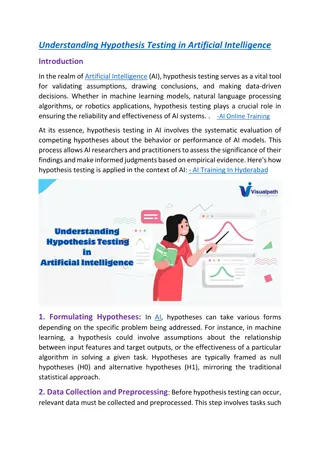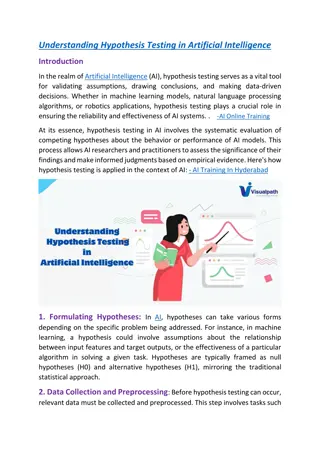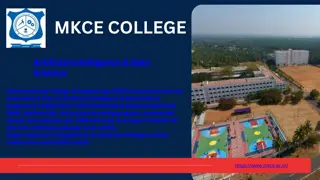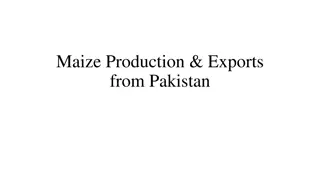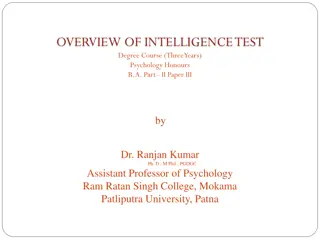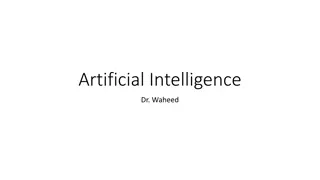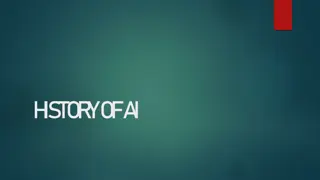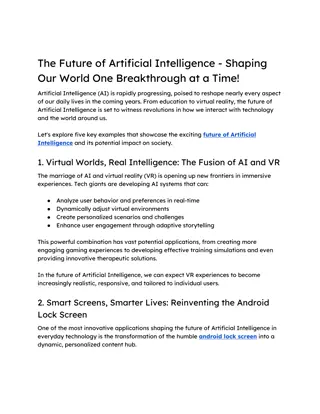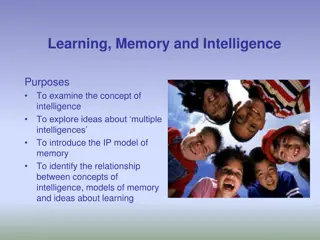Artificial Intelligence Lecture by Dr. Asad Ali Safi at CIIT Islamabad, Pakistan
Join Assistant Professor Dr. Asad Ali Safi from the Department of Computer Science at COMSATS Institute of Information Technology (CIIT) in Islamabad, Pakistan, as he delves into the fascinating world of artificial intelligence. Gain insights into cutting-edge developments, practical applications, and future prospects of AI in various fields. Whether you're a student, professional, or enthusiast, this lecture promises to deepen your understanding and spark your curiosity about AI technology.
Download Presentation

Please find below an Image/Link to download the presentation.
The content on the website is provided AS IS for your information and personal use only. It may not be sold, licensed, or shared on other websites without obtaining consent from the author.If you encounter any issues during the download, it is possible that the publisher has removed the file from their server.
You are allowed to download the files provided on this website for personal or commercial use, subject to the condition that they are used lawfully. All files are the property of their respective owners.
The content on the website is provided AS IS for your information and personal use only. It may not be sold, licensed, or shared on other websites without obtaining consent from the author.
E N D
Presentation Transcript
Artificial Intelligence Lecture No. 18 Dr. Asad Ali Safi Assistant Professor, Department of Computer Science, COMSATS Institute of Information Technology (CIIT) Islamabad, Pakistan.
Summary of Previous Lecture What is CLIPS? CLIPS difference Interacting with clips
Todays Lecture Facts command Watch that Fact Use of backslash, "\ Rules in CLIPS
CLIPS shell The CLIPS shell provides the basic elements of an expert system: 1. fact-list, and instance-list: Global memory for data 2. knowledge-base: Contains all the rules, the rule-base 3. inference engine: Controls overall execution of rules
Making a List As with other programming languages, CLIPS recognizes certain keywords. For example, if you want to put data in the fact-list, you can use the assert command. CLIPS> (assert (duck)) <Fact-1> CLIPS> (facts) f-0 (initial-fact) f-1 (duck) For a total of 2 facts. CLIPS>
What happens if you try to put a second duck into the fact-list? Let's try it and see. Assert a new (duck), then issue a (facts) command as follows
Facts command The keyboard command to see facts is with the facts command. Enter (facts) in response to the CLIPS prompt and CLIPS will respond with a list of facts in the fact-list. Be sure to put parentheses around the command or CLIPS will not accept it. The result of the (facts) command in this example should be CLIPS> (facts) f-0 (initial-fact) f-1 (duck) For a total of 2 facts. CLIPS>
Clearing Up the Facts The (clear) command actually does more than just remove facts. Besides removing all the facts, (clear) also removes all the rules. CLIPS> (facts) f-0 (initial-fact) f-1 (duck) f-2 (quack) For a total of 3 facts. CLIPS> (clear) CLIPS>
CLIPS> (clear) CLIPS> (assert (a) (b) (c)) <Fact-3> CLIPS> (facts) f-0 (initial-fact) f-1 (a) f-2 (b) f-3 (c) For a total of 4 facts.
Retract that Fact Removing facts from the fact-list is called retraction and is done with the retract command. To retract a fact, you must specify the fact- index. CLIPS> (retract 3) CLIPS>
You can also retract multiple facts at once, as shown by the following. CLIPS> (retract 1 3) CLIPS> (facts) f-0 (initial-fact) f-2 (animal-sound quack) For a total of 2 facts. You can just use (retract *) to retract all the facts, where the "*" indicates all .
Watch that Fact One command allows you to continuously watch facts being asserted and retracted. CLIPS> (assert (animal-is duck)) ==> f-1 (animal-is duck) <Fact-1> CLIPS> (retract 1) <== f-1 (animal-is duck) CLIPS> (facts) f-0 (initial-fact) For a total of 1 fact. CLIPS> To turn off watching facts, enter (unwatch facts).
(watch facts) (watch instances) ; used with objects (watch slots) ; used with objects (watch rules) (watch activations) (watch messages) ; used with objects (watch message-handlers) ; used with objects (watch generic-functions) (watch methods) ; used with objects (watch deffunctions) (watch compilations) ; on by default (watch statistics) (watch globals) (watch focus) (watch all) ; watch everything
white space Multiple fields normally are separated by white space consisting of one or more spaces, tabs, carriage returns, or linefeeds. (assert (The duck says "Quack")) FALSE be careful if you insert a carriage return inside of a string CLIPS> (assert (The duck says "Quack ")) <Fact-6>
CLIPS> (assert (grocery-list ice-cream cookies candy sauce)) <Fact-0> CLIPS> (facts) f-0 (initial-fact) f-1 (grocery-list ice-cream cookies candy fudge- sauce)
CLIPS is said to be case-sensitive because it distinguishes between uppercase and lowercase letters. For example, assert the facts (duck) and (Duck) and then issue a (facts) command. You'll see that CLIPS allows you to assert (duck) and (Duck) as different facts because CLIPS is case-sensitive.
CLIPS> (assert (animal-is "duck")) <Fact-1> CLIPS> (assert (animal-is "duck ")) <Fact-2> CLIPS> (assert (animal-is " duck")) <Fact-3> CLIPS> (assert (animal-is " duck ")) <Fact-4> CLIPS> (facts) f-0 (initial-fact) f-1 (animal-is "duck") f-2 (animal-is "duck ") f-3 (animal-is " duck") f-4 (animal-is " duck ") For a total For a total of 5 facts. CLIPS>
What if you want to include the double quotes in a field? The correct way to put double quotes in a fact is with the backslash, "\", as the following example shows. CLIPS> (clear) CLIPS> (assert (single-quote "duck")) <Fact-1> CLIPS> (assert (double-quote "\"duck\"")) <Fact-2> CLIPS> (facts) f-0 (initial-fact) f-1 (single-quote "duck") f-2 (double-quote ""duck"") For a total of 3 facts. CLIPS>
Numeric fields A field which represents a number which can be either an integer or floating-point type field. A floating-point type is commonly referred to simply as a float. All numbers in CLIPS are treated as long long integers or double- precision floats. CLIPS> (assert (number 1)) <Fact-1> CLIPS> (assert (x 1.5)) <Fact-2> CLIPS> (assert (y -1)) <Fact-3> CLIPS> (assert (z 65)) <Fact-4> CLIPS> (assert (distance 3.5e5)) <Fact-5> CLIPS> (assert (coordinates 1 2 3)) <Fact-6> CLIPS> (assert (coordinates 1 3 2))
Making Good Rules To accomplish useful work, an expert system must have rules as well as facts. The pseudocode for a rule about duck sounds might be IF the animal is a duck THEN the sound made is quack CLIPS> (assert (animal-is duck)) <Fact-1> CLIPS> (defrule duck (animal-is duck) => (assert (sound-is quack))) CLIPS>
(defrule duck "Here comes the quack" (animal-is duck) => (assert (sound-is quack))) ; Rule header ; Pattern ; THEN arrow ; Action Only one rule name can exist at one time in CLIPS.
Rule name Entering the same rule name, in this case "duck", will replace any existing rule with that name. That is, while there can be many rules in CLIPS, there can be only one rule which is named "duck". This is analogous to other programming languages in which only one procedure name can be used to uniquely identify a procedure.
The general syntax of a rule is shown following. (defrule rule_name "optional_comment" (pattern_1) (pattern_2) . . . (pattern_N) => (action_1) (action_2) . . (action_M)) ; Left-Hand Side (LHS) ; of the rule consisting of elements ; before the "=>" ; Right-Hand Side (RHS) ; of the rule consisting of elements ; after the "=>" ; the last ")" balances the opening ; "(" to the left of "defrule". Be ; sure all your parentheses balance ; or you will get error messages
The part of the rule before the arrow is called the left-hand side (LHS) and the part of the rule after the arrow is called the right-hand side (RHS). If no patterns are specified
Before going on, let's save the duck rule with the save command so that you don't have to type it in again . Just enter a command such as (save "duck.clp")
Summery of Todays Lecture Facts command Watch that Fact Use of backslash, "\ Numeric fields Rules in CLIPS
